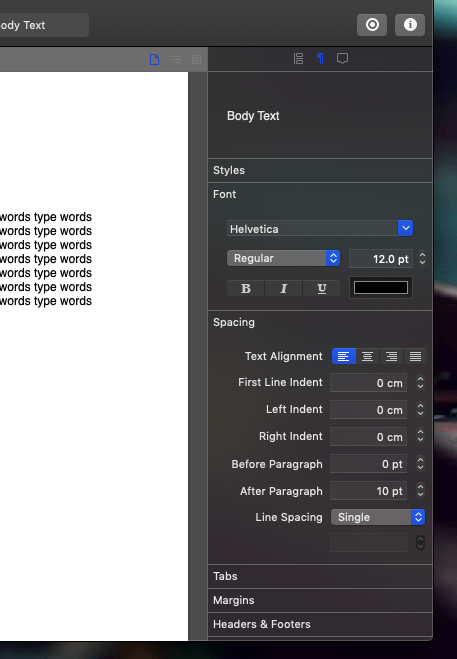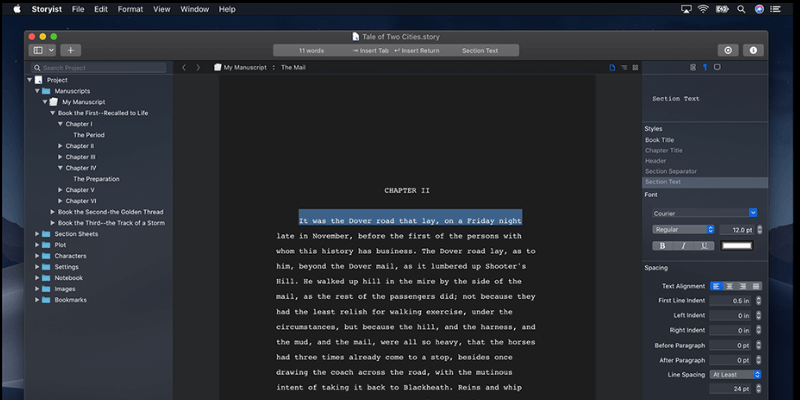
To use the function of synchronizing files between devices, both need to be purchased.

The Mac software is $59 ($29 for upgrade from Storyist 2), and the iOS app is $14.99. First, the price can be a bit much for most authors. The problems with Storyist are few, but fairly significant. This is quite a useful function for when those moments of inspiration strike while away from the laptop. For example, once a draft is started on the Mac, if the author has the Storyist app on their iPhone, they can save the file, leave their Mac at home, and continue composing the draft right where they left off at any time on their iPhone or iPad. Once a file is started on either device, Storyist uses Dropbox to synchronize the file between both devices. Storyist also takes advantage of cloud storage and Dropbox to make story composition a process that works between the Mac and iPhone. Its formatting assistance is comparable to Final Draft (my review of Final Draft can be found by clicking here), and it's no wonder, as Storyist can import and export drafts in tandem with Final Draft, making the process of composing a screenplay all the more stress-free. Its screenplay template performs the proper formatting for you with the tap of the TAB button. Screenplays are quite specific in their formatting, and Storyist has you covered. Storyist is also quite useful in composing screenplays. I found this to be quite useful, as being able to leave notes during a read-through allows the author to experience the cadence and flow of their work while editing. The author can read through and make a note of a part to work on later, rather than having to fix the error on the first read-through. The great usefulness in these notes is in editing. These notes do not appear when the draft is printed or compiled, they are simply available for reference at specific points in the text. These notes appear more as post-its, with the note being placed in the sidebar of the draft itself. Storyist also allows for notes to be tucked into the draft itself. With the note card divisions in place, no ideas have to be lost, and there is an intuitive home for brainstorming. The author can pull out the tab of note cards, make a note for another part of the novel, and never lose their current place in the draft. This is quite a perk for when those "eureka moments" happen.

From the text editor, the note cards are easy to access as well as hide for reference while writing. The author can use note cards to divide the text into chapters, scenes, or any division that is appropriate in the story. Note cards are one of the greatest features. The word processor for drafting is nothing groundbreaking, as it allows for basic composition and altering of basic elements in the text, but everything else that makes Storyist useful is accessible from the text editor. Note cards are an essential element in the usefulness of using Storyist. In other words, once a chapter is in the outline, that part can be moved into a note card to be viewed while composing the draft. Once chapters or scenes are defined in the outline, they can be merged into the draft as pre-drawn divisions. Storyist encourages the author to outline first, as the outline itself translates into the organizational template for the rest of the draft.

The template for outlining is straightforward and easy to learn to use. Whether working on a screenplay or a novel, Storyist provides an easy-to-use outlining tool for getting the basics of the story down in one place. It centers on a page for composition of the draft, but has many functions that allow the author to keep focus on the draft while allowing for multitasking whenever brand new ideas arise in the composition process.

Storyist assists novel writing and screenwriting with a user-interface aimed toward organizing the process of producing either. Storyist is a software system available for the Mac and iOS, and it works with Dropbox to make any file usable on both Mac and iPhone, so you can compose a story in the comfort of home, or jot down an idea on the go. I will feature as many of these options as possible over the next few months and discuss the pros and cons of using each option. There are many options for software geared toward making the process of writing a long-form story all the less foreboding. I am a major advocate for streamlining the process of producing a story, and right now is a fabulous time for authors to get organized. Writing a novel or screenplay, but the enormity of the task is getting in your way? Sounds like it's time to get organized.


 0 kommentar(er)
0 kommentar(er)
